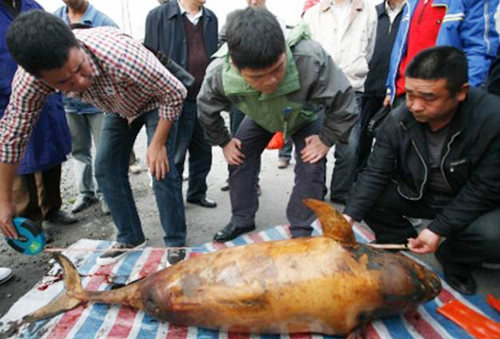|
 |
|
INNOCENT VICTIM: A finless porpoise is found dead in Yueyang City, central China's Hunan Province, on April 13 (XINHUA) |
Animals and plants burst into life in spring across China, but the finless porpoise, one of the most iconic and endangered creatures in the country, did not have a good time.
From March 3 to April 18, 12 finless porpoises were reported dead in the Dongting Lake in central China's Hunan Province, the country's second largest freshwater lake in the middle reaches of the Yangtze River. Fishery authorities of Yueyang, located adjacent to the lake, confirmed six deaths between April 9 and 15 alone.
"To my knowledge, never before have so many dead finless porpoises been found in such a short period," said Xu Yaping, President of the Yueyang Finless Porpoise Protection Association. The non-government organization that Xu heads was set up on January 8 to conserve the species.
"This indicates that finless porpoises in the lake are rapidly approaching extinction," Xu warned.
The finless porpoise, also known as the river pig, has lived in the Yangtze River, China's longest waterway, and nearby lakes for more than 25 million years. With a round smiley face and an intelligence level comparable to that of a gorilla, the animal is adored and respected by local people.
After the white Yangtze River dolphin, another freshwater dolphin subspecies only found in the Yangtze River, was declared "functionally extinct" in 2007, the finless porpoise became the last surviving mammal in the river. Scientists say that it is even rarer than the giant panda.
The recent slew of finless porpoise deaths was first reported on March 3, when two were found dead, one with an unborn baby. They were said to have been killed by boat propellers. Experts say that finless porpoises have poor eyesight, relying on their sonar echolocation system to search for food. These systems might be disrupted by passing boats, leading to collisions and accidental deaths.
According to Xu, in the week starting on April 9, other finless porpoise deaths were successively reported in the Dongting Lake. April 14 was a particularly dark day, when three dead adult porpoises were recorded.
At 2 p.m. on April 14, Xu got a report from a local restaurant owner saying that the body of a dead porpoise had been spotted. Xu arrived at the scene an hour later, and found the badly decomposed carcass of a 1.63-meter-long female porpoise.
At 4 p.m., a local fisherman called in to report another death. It was a 1.3-meter-long female porpoise with a bulging abdomen, which, a later autopsy revealed had contained a nine-month-old, 55-cm-long baby. The baby was two months away from birth. Xu received the news of one more dead finless porpoise at 6:45 p.m.
Twelve deaths in succession have significantly reduced the finless porpoise population in the Dongting Lake. A survey report released by the World Wildlife Fund (WWF) this January said that there were between 1,200 and 1,500 Yangtze finless porpoises in the Yangtze River, with 85 in the Dongting Lake and 300 to 400 in the Poyang Lake, Jiangxi Province's largest freshwater lake.
The finless porpoise population in the Yangtze River is estimated to dwindle at an annual rate of 5-10 percent. Experts say that the species will vanish in 15 years if no effective measures are taken.
But the species' fate might be even gloomier than the data suggests.
"Although 12 deaths were reported, past experiences suggest that there might be more dead finless porpoises that have not been found," Xu said. "Some studies show that for each body discovered, it is likely that there are actually four deaths."
To identify the causes of the finless porpoises' death, Xu organized a team to conduct post-mortem examinations. The team consisted of Xie Yongjun, an experienced veterinarian, and other volunteer doctors.
The team examined three bodies. "There were no fatal wounds on surface and there was no food residue found in their digestive system," Xie said.
He reckoned that 10 of the 12 finless porpoises were either killed by an infectious disease, poisoned, or starved to death.
| 